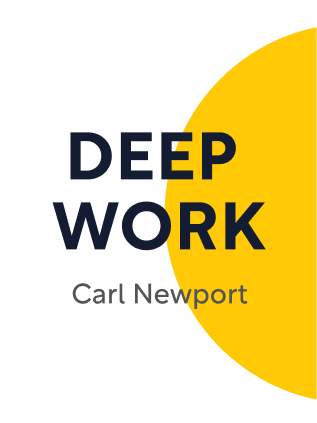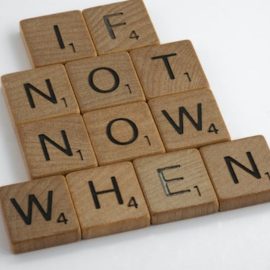

This article is an excerpt from the Shortform book guide to "Deep Work" by Cal Newport. Shortform has the world's best summaries and analyses of books you should be reading.
Like this article? Sign up for a free trial here .
Are you easily distracted at work? What steps can you take to reduce your distractions?
In his book Deep Work, Cal Newport provides steps on how to create a deep work environment. The steps include creating a designated workspace, getting rid of distractions such as social media, training your focus, and making the most of your focused time.
Keep reading to learn how to curb your distractions at work.
Build Your Deep Work Space
In addition to scheduling time for deep work, Newport encourages you to build an environment that supports deep work by reducing distraction triggers.
Step 1: Create a Deep-Work-Only Environment
In order to decrease distractions at work, Newport suggests designating a deep work space, where you go only to do deep work (like a conference room, the library, or an office in your home). Compartmentalizing your location this way will cement the habit of deep work more strongly.
(Shortform note: In Atomic Habits, James Clear discusses the power of using environmental cues to trigger desirable behaviors. Try adding environmental cues to your space—for example, lighting a specific candle each time you start working. Over time, your brain will associate these cues with deep work, and you’ll more easily enter a focused state of mind.)
Step 2: Get Rid of Distractions
Newport points out that a key to spending more time in deep work is to avoid distractions that take you out of deep work.
(Shortform note: You may think that it’s not necessary to cut out potential distractions, instead opting for simple management techniques like placing your phone face down to avoid looking at notifications. However, studies show that when working on the computer, people become distracted, on average, every 40 seconds. Even if your phone is face down on your desk, it’s still an available distraction to reach for.)
Floorplans
Newport argues that the ideal office floor plan is the “hub and spoke” model, in which central hubs—such as meeting rooms, break areas, and cafeterias—allow for communal work and serendipitous meetings and branch off into spokes that lead to quiet, private places for people to do deep work.
(Shortform note: While Newport suggests this model as a solution to the trend of open floor plans, he doesn’t give any type of workaround for those who have no control over the layout of their workspace. In Indistractable, Nir Eyal suggests that workers who may find themselves in a distracting workspace can try creating visual cues to show others that they need to be left alone. This may look like a certain hat you wear when you’re in deep work mode or a small “Do not interrupt” sign on top of your monitor.)
Social Media
Newport says that social media is insidious in that it seems like you’re doing productive things when really the gains are minor. To begin managing the way you use tech, Newport suggests taking the following steps to examine each of your tech tools in regard to their benefits and cost. This will help you see which tools are worth your time and which aren’t.
- List your goals. Make a list of your most important goals—professional and personal—and then list the two or three activities that help you progress most toward these goals. Newport notes that these activities should be specific enough to give you direction, but general enough to be repeatable. (Shortform note: Your goal-supporting activities can include social media. For example, Newport may claim that journalists and authors on social media are wasting their time, but these days, establishing a presence on social media is an essential part of marketing for authors trying to break into the industry.)
- Examine your tech tools: For each of your major tools—for example, Facebook, Twitter, and Reddit—describe how they contribute (or don’t contribute) meaningfully to your important goals. (Shortform note: To fully understand a tech tool’s effect on you and your goals, you must be honest with yourself about why you’re using the tool. Research shows that your intent in using social media determines how negatively or positively it will affect your well-being—those who use social media to check out what others are up to develop negative well-being due to constant comparison, while those who use social media to chat with their friends develop positive well-being due to strengthened social bonds.)
- Try quitting: If you’re on the fence about how much you need a tool, do an experiment: Quit for 30 days and see what happens. Afterward, consider whether your life would have been notably better if you had been able to use that tool. (Shortform note: Breaking out of the dopamine cycle of social media is easier said than done. There will be an adjustment period: Research shows that it takes about eight days for your brain to calm down and become accustomed to a lower level of stimulation.)
Emails
Newport contends that emails are an insidious time suck, both for senders and recipients. He says many people use emails unthinkingly or as a quick way to toss responsibilities into someone else’s court. Newport suggests several ways to reduce the time you spend on the shallow work of unproductive emails.
1) Make sure your emails contain all essential information. Newport explains that when replying to an email, you should articulate: 1) the current state of things, 2) what the ultimate goal is, and 3) what the most effective next steps are. He says this prevents unproductive email volleys and closes the mental loop for you, preventing mental residue from accumulating.
- For example, a bad reply would be, “Yes, let’s meet for lunch. When works for you?” A better reply is, “Here are times over the next week when I’m available. If any of these work for you, let me know, and please send a calendar invite. If none of these work, please send over a few times that do.”
(Shortform note: Newport takes the idea of closing the “mental loop” from David Allen’s Getting Things Done system. When you fail to clearly define and delegate the next steps (no matter how big or small a project), you keep too many thoughts and unanswered questions on your plate and can feel scattered or unfocused. On the other hand, sending out emails that ask recipients for clearly defined actions lets you mentally put the project aside until the action is performed.)
2) Publish your email policy, and respond—or don’t—accordingly. Make sure people who are interested in contacting you know how you’ll handle incoming emails, and which emails you’ll reject. Newport suggests a clear message such as, “Please only contact me via email if you have a speaking engagement, collaboration, or introduction that you think I may be interested in. Please know that I may not reply unless it’s a good fit for my schedule and interests.”
(Shortform note: Newport’s practices aren’t “one size fits all.” While they might work for some knowledge workers—professors, authors like Newport—most knowledge workers aren’t in a position to tell others what they will and won’t respond to. You can, however, simply slow down your response times, as suggested by Nir Eyal. He explains that humans have an innate need to imitate one another—if you reply quickly to a colleague, they’ll reply quickly to you. Consciously slowing down this exchange means you’ll receive fewer emails, and the emails you do get will be more thoughtful—by taking the pressure of a quick response off the other party, you allow them time to think through their response.)
Practice #3: Train Your Focus
As discussed, most beginners can only do about an hour of deep work at a time, but you can train your brain to focus for longer and longer stretches. Newport offers several techniques for this.
1) Let Boredom Happen
Newport points out that most people, in idle moments like waiting in line, reflexively pull out their phones for a quick scroll through social media or their texts. He says that by always filling in these low-stimuli moments with a high-stimuli activity, you deplete your brain’s ability to tolerate boredom—even if you set aside time for deep work, you won’t be able to do the work during that time unless you strengthen your brain’s “focus muscles.” He suggests consciously letting yourself be bored in low-stimuli moments.
- For example, if you’re waiting outside of a bar for your friend, consciously resist taking your phone out. Instead, just sit still and take in whatever’s going on around you.
(Shortform note: Comedian Bo Burnham explores our toxic dependency on the Internet’s endless dopamine supply and entertainment in his song, Welcome to the Internet. He describes the Internet as “a little bit of everything, all of the time” that we’ve become addicted to by design, resulting in a world in which “boredom is a crime.” Warning: Crude language.)
2) Define Metrics of Success
Newport suggests creating a clear metric by which you can define the success of your deep work practices. This practice helps keep you focused on doing your work rather than on what you should be doing with your time or wondering if your results are “enough.”
- For example, you might set a goal to write 500 words every 30 minutes—this way, your task is straightforward and you naturally get two simple progress checks per hour.
(Shortform note: In How to Stop Worrying and Start Living, Dale Carnegie says that setting small goals or challenges makes work a bit like an enjoyable game and prevents you from becoming bored or zoning out. For example, if you’re coming up on 30 minutes with only 400 words written, you’ll likely find finishing those last 100 words an interesting challenge.)
Practice #4: Make the Most of Your Focused Time
Once you have the schedule and the environment, you must actually do deep work. Newport offers several suggestions to make the most of your focused time.
The 4 Disciplines of Execution
Newport outlines four principles of deep work that come from the book The 4 Disciplines of Execution. During deep work sessions, use these principles to optimize your time and focus on the right things.
1) Focus on what’s important. When choosing what to work on, figure out what things have the largest impact. Then, instead of trying to say no to trivial distractions, simply say yes to the most important task or goal. This process helps crowd out shallow tasks that don’t support your goals.
(Shortform note: In Built to Last, Jim Collins outlines steps to creating “big, hairy, audacious goals,” or BHAGs—he urges you to create goals that are clear, push you outside your comfort zone, and are aligned closely with your core values.)
2) Use the right metrics. The most useful metrics in deep work are leading metrics, or metrics you can use in real-time to tweak what your result will be. For example, Newport suggests leading metrics like the number of pages you’ve written or the number of new ideas you’ve generated. These give real-time feedback that helps you see how effective you are at deep work. In contrast, a lagging metric would be how many papers you’ve published at the end of 2021—at that point, you can’t go back and change your behavior in order to publish more papers in the year.
(Shortform note: The authors of The 4 Disciplines of Execution warn that leading metrics are more difficult to measure than lagging metrics (for example, it’s easier to measure how much you weigh—a lagging metric—than it is to measure how many calories you’re eating—a leading metric. You’ll have to make a habit of collecting data on your leading metrics.)
3) Keep your metrics visible. Making your leading metrics visible will motivate you to keep up the habit and allow for more frequent celebration of successes. Newport suggests keeping a physical display in the workspace that shows your leading metric, like a small whiteboard where you mark off hours spent in deep work.
(Shortform note: Studies show that continuously celebrating small achievements and feeling a sense of progress is a fairly easy way to boost your overall happiness—this is important because the strongest indicator of productivity is the way you feel. Research reveals that when you feel positively toward your work, your productive performance naturally increases.)
4) Create accountability where possible. Periodically analyzing your deep work will keep you honest about how well you lived up to your goals. Newport explains that this exercise will show you where you can improve. He suggests setting up a weekly review to see what you’ve achieved in the past week and make a plan for the coming week. If you’ve had a negative week, make changes to your schedule to cut out factors that led to it.
(Shortform note: If you struggle with making behavioral changes based on a review of your own behaviors, you might try adding a more social aspect to your accountability practices. In Indistractable, Nir Eyal recommends social precommitments, which make it harder for you to perform undesirable behaviors. For example, you might make a precommitment to have someone else review each week’s deep work report. You’re more likely to stay away from shallow work and focus on hitting your goals because of the added pressure of being “watched” by someone else.)
Learn to Say No to Shallow Work
Newport warns that like most knowledge workers, you’ll face invitations to partake in various forms of shallow work, such as meetings, committees, and travel. He suggests saying no to this shallow work by providing a vague enough response that the requester cannot find a loophole that they could use to get you to say yes. For example, you might say, “Sounds interesting, but I can’t make it because of schedule conflicts,” or, “Thank you for inviting me, but I won’t be able to make it.”
(Shortform note: Critics point out that in many industries, it’s important for each team member to contribute to the group—it’s unfair to expect others to take on shallow tasks while you refuse to do them. Newport’s role as a professor isn’t an exception to this expectation: Joining committees, networking, and doing other shallow tasks are becoming increasingly vital parts of finding employment in academia.)
Ritualize Your Workday Shutdown
To fully get your mind off work and relax, Newport suggests creating a shutdown ritual. He says this ritual should help you check your work for anything you forgot and plan your next day’s work. For example, you could check your emails for any last urgent items, update your to-do list, check your calendar for upcoming deadlines, and say, “All done,” or a similar phrase to explicitly mark the end of the workday.
(Shortform note: You may want to add reflective time into your workday shutdown—research shows that employees who spend 15 minutes at the end of their workday reflecting on what they learned during the day perform about 23% better in their work than those who don’t take time for reflection.)
Newport stresses that an important benefit of the end-of-day ritual is that it helps reassure you that things will be fine when you shut down. When you create a shutdown ritual, instead of feeling anxious about unfinished tasks, you’ll feel confident that all the important tasks are accounted for, and that you’ll make meaningful progress the next day. This gives you more time to fully relax in your time off from work. (Shortform note: This ritual also sets clear boundaries between work and not-work, which is especially important as more knowledge workers fall into the trap of overworking when working from home.)

———End of Preview———
Like what you just read? Read the rest of the world's best book summary and analysis of Cal Newport's "Deep Work" at Shortform .
Here's what you'll find in our full Deep Work summary :
- How deep work is critical for performance and productivity
- Why focus is like a mental muscle
- Why willpower isn't as good as a ritual






